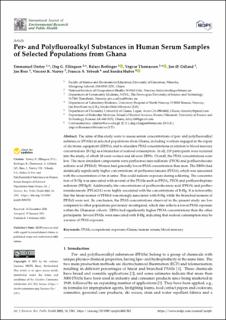| dc.description.abstract | The aims of this study were to assess serum concentrations of per- and polyfluoroalkyl substances (PFASs) in selected populations from Ghana, including workers engaged in the repair of electronic equipment (ERWs), and to elucidate PFAS concentrations in relation to blood mercury concentrations (B-Hg) as a biomarker of seafood consumption. In all, 219 participants were recruited into the study, of which 26 were women and 64 were ERWs. Overall, the PFAS concentrations were low. The most abundant components were perfluorooctane sulfonate (PFOS) and perfluorohexane sulfonic acid (PFHxS). Women had generally lower PFAS concentration than men. The ERWs had statistically significantly higher concentrations of perfluorooctanoate (PFOA), which was associated with the concentration of tin in urine. This could indicate exposure during soldering. The concentration of B-Hg was associated with several of the PFASs such as PFOA, PFOS and perfluoroheptane sulfonate (PFHpS). Additionally, the concentrations of perfluorodecanoic acid (PFDA) and perfluoroundecanoate (PFUnDA) were highly associated with the concentrations of B-Hg. It is noteworthy that the linear isomer of PFHxS was strongly associated with B-Hg while the branched isomers of PFHxS were not. In conclusion, the PFAS concentrations observed in the present study are low compared to other populations previously investigated, which also reflects a lower PFAS exposure within the Ghanaian cohorts. ERWs had significantly higher PFOA concentrations than the other participants. Several PFASs were associated with B-Hg, indicating that seafood consumption may be a source of PFAS exposure | en_US |

